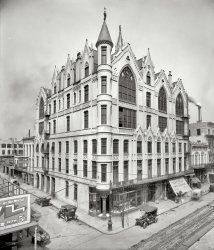
MAY CONTAIN NUTS

Search Shorpy
SHORPY ART

Framed or unframed, desk size to sofa size, printed by us in Arizona and Alabama since 2007. Explore now.
Join and Share
Ad-Free Shorpy
Shorpy is funded by you. Patreon contributors get an ad-free experience.
Learn more.

Recent comments
- Tobacco cam
- Basic fact I learned only later in life
- Put a Lid on it!
- Pinstripes in the Tower
- Sound enhancement
- 3438 in '38
- Second Career
- Their days are numbered
- Only the Sensor
- Train control mechanism
- Rarest of the Rare?? & Classy 3400 Class
- Control Mechanism
- Those standpipes
- Wrenches
- International D-40 I believe
- Job prospects
- You had me at Train
- Land of the free
- Broad-Exchange Bldg
- Parking innovation
- The old block
- "Peck turned a sweet propeller"
- National Bank Building
- Notch shot
- Straight ahead (right, left, left, right)
- Ship lifespans
- New service
- You Say Station, I Say Potato ...
- Iron Age
- Thank you, Cornelius Vanderbilt
Member Photos
The Shorpy
Printporium
Printporium
Search Shorpy
Search results -- 30 results per page
- Street View: 1937
- New Orleans circa 1937. "837 Gov. Nicholls Street." We just dropped by to say ...
FBJ What a treasure in photographs she has left New Orleans. Here is Frances Benjamin Johnston in 1904.
And the front yard ... the stairs on the right.
(The Gallery, F.B. Johnston, New Orleans) ... Posted by Dave - 07/22/2012 - 4:42pm -
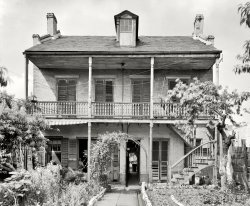
- Memphis: 1906
- ... Capt. Bixby "learned" Clemens the river from St. Louis to New Orleans, and although they saw each other little since 1861, the captain ... Posted by Dave - 08/14/2012 - 11:36am -
![Memphis: 1906 Memphis, Tennessee, circa 1906. "Mississippi River levee from the bluff." 8x10 inch dry plate glass negative, Detroit Publishing Company. View full size.
Snagboat historyAll U.S. snagboats are based on the Heliopolis, built in 1837 by Henry M. Shreve. The largest crane currently operated by the COE is also named for Shreve.
Corps of EngineersI love the fact that the Horatio Wright wheelhouse is topped by a wonderful model of the Army Corps of Engineers' famous castle insignia.
All Snaggled UpI can't say about the others, but the four boats on the right look to be snag boats run by the US Army Corps of Engineers. The name of the boat on the far right, the John N. Macomb, tipped me off. I thought I was clever until I read US Snag Boat Wright on the paddle of the left-most in the group.
Snag boats were used by the Corps for decades to remove debris from those river courses which were once important to interstate commerce. Lots of stuff on Google about them. If you're interested, the snagboat Montgomery http://montgomery.sam.usace.army.mil/about.html is an historical monument, and you can tour the old tub way down in Alabamy.
By the way, the Macomb was named after Col. John N. Macomb. Macomb was a graduate of West Point, and apparently a member, like John C. Fremont, of the Corp of Topographical Engineers. His claim to fame was his exploration of the canyon lands of the Colorado River, in the four corners region. (There are books with photos--look it up.) He was also a Civil War balloonist and apparently served in the Mexican War, too. Quite a career.
Horatio G. Wright was a general officer in the Corps of Engineers. I haven't found much about him. Maybe another reader can enlighten us. But it looks like the Corps like to name their boats after engineers in the Corps. Surprise.
SnaggersThe heavy A-frames and tackle were used to remove snags, large trees that had washed down the river until one end grounded out. The trees would remain there, bobbing up and down in the current, thus often called "sawyers" after the motion of the sawyer at the top of a pit saw. (The guy down below eating sawdust was the "pitman", later replaced by a lever mechanism of the same name, yielding an automotive term still in use -- pitman arm.)
Such a snag could tear the bottom out of a wooden boat, so needed to be removed by a snag boat as soon as possible.
Note the C.O.E. castle logo atop the wheelhouse of the Horatio Wright. Elsewhere on Shorpy are Civil War Engineers with the same castle badge.
There is a fiddle tune named "Mississippi Sawyer", named for the motion of the fiddler's elbow, "rockin the bow."
The age of horse and steamIt is only by seeing these pictures that you realise how much the world continued to rely on horsepower and steam power to drive the economy for much of the first half of the 20th century. A fascinating picture full of life.
BridgeThe Frisco Bridge seen in the background was built in 1892,at that time it was the only bridge across the Mississippi south of St. Louis, it is still in use today and has always been a railway bridge.
Mark Twain's river mentorThe Horatio Wright was captained by none other than super-pilot Horace Bixby from Mark Twain's "Life on the Mississippi"!
An interview with him was published in Waterways Journal in April 1910, just four years after this picture was taken:
HOW MARK TWAIN GOT ON THE RIVER.
Among those who are competent to give personal reminiscences of Mark Twain are Capt. Horace Ezza [sic] Bixby, probably knew the humorist earlier than anyone now living in St. Louis, and doubtless knew Clemens, the pilot, better than any other man now living.
Capt. Bixby is pilot of the United States snagboat Wright at the age of 84 years. He resides with his son-in-law, Dr. Louis T. Pim, 5910 Etzel avenue. Capt. Bixby "learned" Clemens the river from St. Louis to New Orleans, and although they saw each other little since 1861, the captain cherishes his recollections fondly.
In Memphis one time, he told a reporter that he wished Mark Twain were dead so he wouldn't be bothered in retailing reminiscences about him longer. He was annoyed when the remark was printed, but there is no record that Mark Twain ever heard of it, and if he had, it was just the sort of a whimsicality that he would have appreciated. But when Mark Twain hung on the brink of the beyond, a flood of recollections came to the captain, and looking out over the green lawns he saw the little dingy pilot house of the Paul Jones, with a lank young fellow standing in the doorway saying in that enduring drawl: "Say, will -- you -- teach -- me -- the river?"
Snag BoatsExcellent view of two snag boats. Their duty was to remove snags (hazards to navigation, usually sunken logs) from the river. The split bow allowed them to get over the snag and then lift it out of the water with the A-frame crane.
Wow!Wow, what a shot! My grandfather Henry Schmidt on my mom's side was an engineer on the Horatio Wright at this time. Mom was a year old or less when this was taken. Thank you!
TintedHere's Detroit Publishing Company's 1906 colorized postcard from the same image.
Port and Starboard.I notice that most of the two side-by-side funnels on paddle steamers shown throughout the Shorpy site have a J-shaped bracket at the top of each funnel with small pulleys at the outer end of the J with lanyards to the deck below so that illuminated coloured lanterns can be hoisted to the funnel tops at night.
This would indicate whether the steamer in the distance is approaching or going away as seen from the pilot house on the steamer you were on.
I presume the lanterns would be green for right/starboard and red for left/port side as per salt water rules.
On the stern of the 'Transit' in the lock shown elsewhere at Shorpy, there are two small boxes with side doors at the stern above the paddle wheel which have stern lanterns within.
Thank You.
(The Gallery, Boats & Bridges, DPC, Horses, Memphis)](https://www.shorpy.com/files/images/4a13366a.thumbnail.jpg)
- Walton Way: 1905
- ... the line ran down Central Ave. in the center boulevard (in New Orleans they call it the "neutral ground') and worked its way back to Broad ... I missed the streetcar era in Augusta, I later lived in New Orleans and rode them almost daily.
Definitely Augusta, my home town ... Posted by Dave - 08/13/2012 - 6:57pm -
![Walton Way: 1905 Circa 1905. "Summerville, South Carolina -- Walton Way." 8x10 inch dry plate glass negative, Detroit Publishing Company. View full size.
Could be AugustaAs a lifelong resident (60 years) of Augusta, GA, I feel confident in saying this is indeed Walton Way. However, it's in Augusta, not SC. And, this particular section of it is in the "Summerville" neighborhood of Augusta. It looks as though we're looking down the familier steep hill where The Bon Aire Hotel and The Partridge Inn are both located at the bottom. As a matter of fact, The Partridge Inn can just be seen in the distance in the center of the picture. Of course I could be wrong...probably am.
Tree TownSo many trees to trim, so little time. Even though Augusta, Georgia has an average high of 58 and low of 33 in January, I am sure they can have an ice storm every now and then. I would guess that a heavy one would put this town out of business in 1905. Look at all the tree limbs over power, telegraph, telephone and even streetcar lines.
The tram is the only clueTried to find current pics of Walton Way. Only thing now in Summerville is Walton Place... a little cul-de-sac in a modern subdivision. But, close by is another development with street names such as Tram Blvd and Iron Road. My guess is that the area was bulldozed for new homes but the builder kept some of the history in the street names.
Ahhh, that’s better.Obviously the trollies clean-up after themselves in Summerville.
Too Late for Pony Express, Too Early for FedExOn the left, u-bolted to the metal post, what are those two box enclosures? Is the small one a Post Office mail drop? And I have no idea about the larger one.
Gould's Corner, Augusta, GAThis photo was taken from Gould's Corner in the Summerville historic district in Augusta, GA. The photo is listed in the LoC database at the end of a short series in Augusta; my guess is that the photographer simply labeled it "Summerville," then he (or someone else) later added the "S.C." based on the photos that followed. In any case, the house at the left is the Gould-Weed house. Just down the road, Walton Way takes a jog left, as can be seen by the curve in the trolley tracks. Here's the (overexposed) street view today:
View Larger Map
If you look at Bing's street view of the house from a few different angles, you can see that the architectural details match.
tree hazardsThough there is evidence of some tree pruning having been done, a lot of work remains to protect all those inmeshed utility lines from the next big wind storm and any swinging/falling branches.
MislabeledI suspect this photo is mislabeled. In Augusta, Georgia, there is a community also called Summerville. Walton Way, in the former place, is a major main road and vintage photos show trolleys were in service there. To my knowledge, my native Summerville, South Carolina never had trolleys.
Relay@lesle: The bigger box if possibly a postal relay box, to "refill" the letter carrier's sachel with delivery mail along the route. If not, then my guess would be garbage can. I agree with you about the smaller box being a mail drop box for customers.
Today it costs millions ofToday it costs millions of dollars a mile to build a light rail system. Back then they just laid down track and drove the cars on it.
Corrections and reflectionsAs others have noted, this Summerville is a section of Augusta, Georgia, on The Hill, as locals say. This is a view of Walton Way, corner of Milledge Rd., looking toward downtown (roughly compass east). The house on the corner at left is still standing, nicely restored in recent years. Streetcars (the preferred term in the South, not "trolleys") last ran in Augusta in 1937, four years before I was born there. My grandparents lived on the Hill, at 2504 Helen St. (house now demolished), and I attended William Robinson Elementary School through third grade. I would ride my bike down Arsenal Ave. to Walton Way and thence to school. The streetcar tracks were in the concrete pavement for many years after service ceased; in fact, you could trace practically the whole line back up to Monte Sano Ave. and, in the other direction, down the Hill to Thirteenth St. and then over to Broad St. From Monte Sano the line ran down Central Ave. in the center boulevard (in New Orleans they call it the "neutral ground') and worked its way back to Broad St. It was a belt line, i.e., cars ran in a continuous loop in both directions. Although I missed the streetcar era in Augusta, I later lived in New Orleans and rode them almost daily.
Definitely Augusta, my home townThe photo was taken at the corner of Milledge Road and Walton Way, looking e-s-e toward downtown. Growing up in Augusta in the 1940s, I distinctly remember the streetcar tracks on Walton Way, although the cars went out in 1935 on the Walton Way-Central Ave. belt line, and in 1937 on the rest of the system. Tracks remained on portions of Walton Way out to Monte Sano Ave., and on Broad St. out to 13th St. and from 15th out to Julian Smith Park. On Walton Way it was single track from Milledge to Monte Sano, and there was a turnout into the Arsenal. Trackage was standard gauge, T-rail (no girder rail, i.e., no flangeways). The original street railway here was the Augusta & Summerville Railway, Summerville being that portion of present-day Augusta known to the natives as "The Hill." My paternal grandparents lived on the Hill at 2504 Helen St. and I spent summers there with them well into the 1950s. Augusta was a great railroad town also, with the main shops of the Georgia Railroad located near the grand Union Station ("the depot" to the locals). All of that is demolished. The Southern, Atlantic Coast Line, C&WC, and the Ga. & Fla. also served Augusta. While I missed the streetcars in Augusta, I later rode them in New Orleans, and became (and remain) a trolley "nut."
Big box of news? Could that be an early paper vending machine, two cents for a copy?
Looks like AugustaI've lived in Augusta for 13 years now and as a resident and avid photographer, this defiantly looks like Walton way.
["Defiantly"? Definitely. - Dave]
(The Gallery, DPC, Small Towns, Streetcars)](https://www.shorpy.com/files/images/SHORPY_4a17061a.thumbnail.jpg)
- The Milkmobile: 1903
- Circa 1903. "A New Orleans milk cart." With a one-horsepower motor. 8x10 inch dry plate glass ... then and now scenes. My parents took their honeymoon in New Orleans back in 1947 and had a dinner at Pat O'Briens Bar.
Great ... environs.
(The Gallery, DPC, Eateries & Bars, Horses, New Orleans) ... Posted by Dave - 07/19/2012 - 4:32pm -
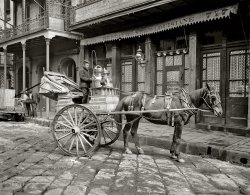
- Organ Meet: 1924
- "Organ grinder, New Orleans, 1924." Nitrate negative by Arnold Genthe. View full size.
... the McDonogh Public School #15 on St. Phillip Street.
New Orleans once had more than a dozen schools numbered and called McDonogh. ... recluse John McDonogh died in 1850, the residents of New Orleans and
Baltimore were surprised to find themselves the beneficiaries ... Posted by Dave - 05/05/2020 - 3:46pm -
![Organ Meet: 1924 "Organ grinder, New Orleans, 1924." Nitrate negative by Arnold Genthe. View full size.
Offal TitleOh, man --
724 Saint Philip StThe large building on the left, across from Montalbano's Italian Grocery, is now gone, but everything else looks basically the same.
Organ Grinder Econ 101? How did one actually make a living as an organ grinder?
The Missing BuildingThe sizable gap was a building that explains the group of kids seen in the photo. It was the McDonogh Public School #15 on St. Phillip Street.
New Orleans once had more than a dozen schools numbered and called McDonogh. Why? A local history of the schools explains:
"When wealthy recluse John McDonogh died in 1850, the residents of New Orleans and
Baltimore were surprised to find themselves the beneficiaries of his considerable estate.
His will specified that the money was to be used for the purpose of establishing public
schools in the two cities for "education of the poor of all castes and races." When the
complicated details had been hammered out and the bequest had been honored, over 30
public schools bearing John McDonogh's name had been constructed in New Orleans.
Finding photos of the original McDonogh schools was more difficult than I thought it would
be. Most of the McDonogh schools were demolished and rebuilt very early on, as the
population increased and larger buildings were required. (Many of these second McDonogh
schools are still standing, more than a century later.) Some were even rebuilt a third time. "
But not McDonogh #15. Farewell ...
Where's The Monkey?The little girl appears to be looking for something.
Flora PowerThese kids undoubtedly had ironclad immune systems.
Grinding for penniesOrgan grinders made money by receiving tips for their musical performance. Many folks considered them to be only one step up from beggars. However, at that time music itself, particularly for the less fortunate, was a rare thing to hear unless one's family had talent and instruments, so the performance was actually worth spending a few pennies. Often the grinders would have a monkey or human performers with them, sometimes in costume, who would stage a kind of street performance to jazz it up a bit.
Ultimately the grinders were driven out because music licensing came into effect, effectively preventing grinders from performing the current hits, such as they were. Very few actual grind organs still exist as a result.
This fellow works a long day, since he has a lit lantern with him, foretelling his lengthy evening's work ahead.
I love the fact that the performer has stuffed his ears with cotton to dampen the deafening noise.
[I suspect the lanterns were a city requirement for carts. - Dave]
Not a Mighty WurlitzerHere's a video demonstrating what those simple pipe organs sound like along with a glimpse at how they work. https://www.youtube.com/watch?v=p_PsFtxIIcw
Another with a trove of period photographs. https://www.youtube.com/watch?v=9efnMNP-s0Q
You Too can be an Organ GrinderA quick search of the internet reveals a kit organ that is operated by hand power and a punched paper roller not unlike a player piano. This one, while new, seems a tad wheezy.
https://www.youtube.com/watch?v=p_PsFtxIIcw
Organ grinder girlThe recent run of circa 1910 photos have been wonderful: Manchester NH, Cleveland, NYC, Charleston, LA. (Not so big on the four doctors and the arthritic foot in 1949.) But I keep going back to New Orleans in 1924, on Tuesday, four days ago, to reinspect the central character (for me) that I’ve come to think of as the organ grinder girl: her face in profile, prominent nose, and a distinct spark in her step. She is so taken with the cart and maybe even the organ grinder fellow. All the other kids have something going on, too, but I have come back every day, for these past few days, as one does frequently on Shorpy, to look at this arresting girl.
(The Gallery, Arnold Genthe, Kids, New Orleans)](https://www.shorpy.com/files/images/SHORPY-7a03387a.thumbnail.jpg)
- Bourbon Boys: 1924
- Bourbon Street and Ursulines Avenue circa 1924. "New Orleans organ grinder." Nitrate negative by Arnold Genthe. View full ... Last Relic of Minstrelsy
The Picayune's Guide to New Orleans,
Sixth Edition, 1904.
Of an evening, especially in ... Posted by Dave - 05/05/2020 - 3:22pm -
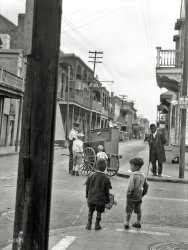
- Lugger Landing: 1906
- ... Along the Mississippi circa 1906. "Oyster luggers at New Orleans." 8x10 inch dry plate glass negative, Detroit Publishing Company. ... size.
Picayune Tier
Standard history of New Orleans, Louisiana, 1900.
Sight-Seeing.
A stranger should ... Posted by Dave - 08/08/2012 - 2:30pm -
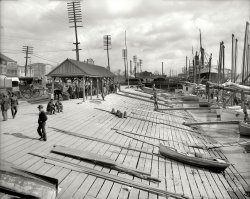
- Camp and Canal: 1905
- New Orleans circa 1905. "Camp Street." A different perspective on the ... full size.
Beautiful! All these pictures of old New Orleans and BSL (Bay St. Louis) are making me so homesick. Thanks so much ... Can't count how many times I've been right there, I miss New Orleans so much! (I must have been a native in a former life, I feel at ... Posted by Dave - 08/20/2012 - 10:48am -
![Camp and Canal: 1905 New Orleans circa 1905. "Camp Street." A different perspective on the previously posted view along Canal Street. Detroit Publishing glass negative. View full size.
Beautiful!All these pictures of old New Orleans and BSL (Bay St. Louis) are making me so homesick. Thanks so much for posting them, and please keep them coming!
Looking upriver.Not a T-shirt or camera shop in sight. How did they survive?
A. Baldwin & Co. Ltd. HardwareA rooftop advertisement for my great-grandfather's hardware firm!
Zee beelding... ees steel zayre!
View Larger Map
Can't do much with...A streetcar named Prytania.
CokeThat C. Lazard Co. sign on the right looks like what I think of as the "Coca-Cola" font. Anyone know the proper name of this font? This was post-Coke wasn't it?
[The Coca-Cola logo is Spencerian script. Coca-Cola got it start in the 1880s. - Dave]
Been there!Can't count how many times I've been right there, I miss New Orleans so much! (I must have been a native in a former life, I feel at home there, instead of Florida.)
(The Gallery, DPC, New Orleans, Streetcars)](https://www.shorpy.com/files/images/4a10795a.thumbnail.jpg)
- The Tower: 1937
- New Orleans circa 1937. "The Tower, 1015 Chartres Street." 8x10 inch negative ... from adornment?
Stella !! Whenever I see these old New Orleans courtyard scenes on Shorpy.
Keep the floors clean I love the ... Chartres Street. I stay there every year when I visit New Orleans. Amazing hotel right in the heart of the Quarter. I've stayed in ... Posted by Dave - 08/30/2012 - 11:04am -
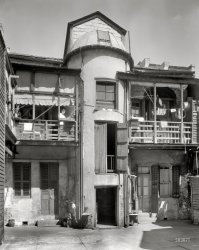
- Fruit Growers Express: 1903
- Circa 1903. "Unloading bananas at New Orleans." Come Mr. Tally Man! 8x10 inch dry plate glass negative, Detroit ... hot weather.
(The Gallery, Boats & Bridges, DPC, New Orleans, Railroads) ... Posted by Dave - 08/05/2012 - 4:27pm -
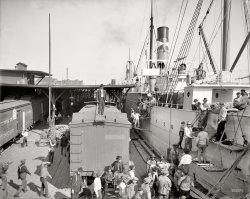
- Working Lunch: 1902
- ... during the 1913 flood. The contrast between Dayton and New Orleans is remarkable to me and is something to learn from.
We're beat ... Posted by Dave - 10/16/2015 - 10:32am -
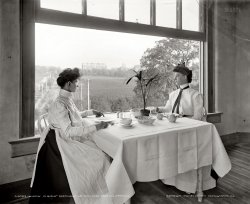
- Selma, Alabama: 1935
- ... posters on the wall so i googled it. "silas green from new orleans" was a minstrel show that toured from 1905 to 1957.
you can get ... Posted by Dave - 05/14/2019 - 10:27am -
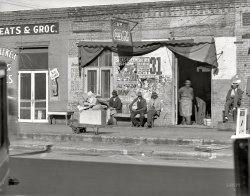
- French Opera House: 1900
- Circa February 1900. "French Opera House, New Orleans." 8x10 inch dry plate glass negative, Detroit Publishing Company. ... Chill. Enjoy Shorpy as always.
(The Gallery, DPC, New Orleans, Streetcars) ... Posted by Dave - 08/14/2012 - 3:57pm -
![French Opera House: 1900 Circa February 1900. "French Opera House, New Orleans." 8x10 inch dry plate glass negative, Detroit Publishing Company. View full size.
Do NOT LikeDave:
The "Like" icon seems to have shown up most recently, possibly yesterday. I, for one, Do NOT Like the "Like" icon. This ain't Facebook, or Digg, or Twitter...my guess would be that people who appreciate and frequent this site couldn't care less about the mutual masturbations of the social media phenomenon.
[Your eloquent critique notwithstanding, Shorpy has 2,655 friends on Facebook (link below). Through their friends and friends of friends, thousands more people have been introduced to this site! - Dave]
http://www.facebook.com/shorpy
Awesome!There's not too many higher quality pictures of the Old Opera House. Many thanks for sharing!!
I bet the smell was ripe!With animals and open street drains. It must have been pretty bad, I understand how they couldn't dig underground sewers due to the high water table!
Re: Social NetworkingFacebook? Back in the 'old days' Shorpy was a hard-edged realist who didn't believe in Social Networking. As a non-facebooker, it's weird that one the first things on the Facebook page is the question, "Wrong Shorpy Higgenbotham? Search for others:" As if there were others.
[Ahem. "Higginbotham." - Dave]
Do LikeFacebook is how I found this fabulous website, and now I visit and enjoy daily. :) Shorpy is an amazing resource and an invaluable window into the past. I'm so glad I did find a way here. I'm constantly amazed with the luminosity of the images and the stories behind them.
And yes, I Facebook daily, too. Social media has its place, and if it helps to share history and spark an interest in and appreciation for what has gone before, then it at least serves another good purpose aside from remaining in contact with people easily. Having that button saved me time to cut and paste the link today - and I was glad to be able to share it easily!
Not long for this worldSadly, the French Opera House would stand for only another nineteen years. Built at the corner of Bourbon and Toulouse Streets in 1859, it was destroyed by fire on the night of December 4, 1919.
Ow!If I were into editing pictures I think I'd have to put sparks where it gives the illusion that the "This way to Levy's" finger touches the wire.
SalammboThe opera advertised, not the one of the same name in Citizen Kane, had its American premiere in this house in 1900.
Haunted by the Witch of the French OperaThe Witch of the French Opera lived in a house at Bourbon and Toulouse where the opera house once stood. Spurned by her young lover, the old Madam committed suicide, threatening in a final note: "I will Come back from the dead I will return, And kill those that have hurt me!" An many say return she did, to kill the man and his new love and to haunt tourists and locals for many decades to come.
I think the simplest thingwould be to ignore the Like button if it bothers you. It's there so people can show appreciation but not have to make a comment. It a very small thing. Chill. Enjoy Shorpy as always.
(The Gallery, DPC, New Orleans, Streetcars)](https://www.shorpy.com/files/images/4a04320a.thumbnail.jpg)
- Hobo Life: 1915
- ... hay."
I can hear Arlo Guthrie singing "The City Of New Orleans" -- the part that goes "the rhythm of the rails is all they feel." ... Posted by Dave - 11/15/2010 - 5:24pm -
![Hobo Life: 1915 Location unknown circa 1915. "Tramps in boxcar playing cards." 5x7 glass negative, George Grantham Bain Collection. View full size.
On their wayFive years later, they attended the banquet for the Civitan Club.
My Dad, in 1933, at age 16 left his home in depression-ridden Flint, Michigan, to hobo his way via rail to California. He managed to return home to Flint, and eventually graduated from the University of Michigan at Ann Arbor in civil engineering, becoming a professional railroad engineer. At his retirement, he was the only person to have served as Chief Engineer for 3 major railroads: the Wabash, the Norfolk and Western, and the B&O-C&O (predecessor to CSX).
Hobo or TrampThis is according to Wikipedia:
Tramps and hobos are commonly lumped together, but in their own sight they are sharply differentiated. A hobo or bo is simply a migratory laborer; he may take some longish holidays, but soon or late he returns to work. A tramp never works if it can be avoided; he simply travels. Lower than either is the bum, who neither works nor travels, save when impelled to motion by the police.
Not an easy lifeHobos faced all sorts of dangers -- from freezing to death on trains, to being beaten by railway "bulls," to being murdered by other hobos. It wasn't uncommon for newspapers to include methods of dealing with unwanted hobos, including hints on poisoning them. My father rode the rails for a time until he witnessed the death of another man who was knocked from the top of a train.
I highly recommend "Hard Travellin': The Hobo and His History" by Kenneth Allsop. A fascinating glimpse into the life and history of hobos.
Emmett KellyThat guy on the right sure does look like him, only he doesn't need any makeup.
In the cardsJudging by the number of cards per player the scorecards on the ground, I'm guessing these guys are playing three-handed euchre.
Since euchre is played mainly in the upper Midwest, I'm going to guess this was within smelling distance of the Great Lakes.
[How far away from the Great Lakes do they have to get before they stop playing? - Dave]
Works & DreamsForget Wikpedia, trust the old hoboes who described it this way::
A hobo works and dreams.
A tramp dreams and works.
A bum is too lazy to do either.
Mum and the bumFor the first several years of my life my father worked for Southern Pacific as a telegrapher. Our family routinely had contact with hobos, tramps and bums.
It was not uncommon to find some very well educated men traveling the rails as a hobo. I was told by my mother that many times she would let hobos hold me as an infant and they would sit and talk. She said you could tell it made them think of home.
Hobo camps were common and most people left them alone. When tramps or bums hit the area there was more often trouble.
My father related a story to me in which a bum burst into our single room home (under the Swithing Tower) one night when it was cold. Father was upstairs at work. A bum was going to force his way in and stay by the iron stove. What he did not know was my mother was a "crack shot" with a small pistol she kept tucked away. Rather than call for Father, she pulled the gun out and forced the man outside. The bum challenged her. He didn't think she could handle the gun. Mother pointed it at a bottle by a fencepost and fired. Now, more than likely it was by luck, but the bottle shattered. The bum ran for the hills all wide-eyed.
Word got around that there was a lady living at the Yard "who could kill ya!" We never had problems again. Not surprisingly, the hobos in the area always kept an eye out for our family and made sure we were safe!
As we got older, all of us Railroad Kids would wander off to the camps and visit with the hobos. It was a different time. A time when you knew who you could trust.
Dressing styleYou know, I think these tramps are actually far better dressed than most employed men I see on the street today.
Four months ago"I told my wife I was running out to get some cigs."
"Are you in or not?"
"Oh, sorry. I'll see your twigs and raise you a handful of hay."
I can hearArlo Guthrie singing "The City Of New Orleans" -- the part that goes "the rhythm of the rails is all they feel."
I dreamed I saw Joe Hill last nightalive as you and me!
Family loretells that my great-uncle John Shea was a hobo back then. I wonder if one of these guys is he.
(The Gallery, G.G. Bain, Railroads)](https://www.shorpy.com/files/images/00403u.thumbnail.jpg)
- Seed and Feed: 1935
- December 1935. "Waterfront in New Orleans. French market sidewalk scene." Large-format nitrate negative by ... they typhoid-free?
(The Gallery, Cars, Trucks, Buses, New Orleans, Walker Evans) ... Posted by Dave - 09/05/2012 - 6:05pm -
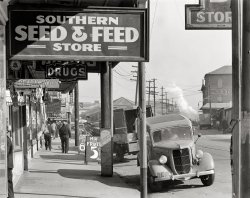
- Raised on Radio: 1942
- ... runs in the west side of the Mississippi from Minnesota to New Orleans.
In February 1942, there would have been little of interest to ... Posted by Dave - 08/13/2021 - 5:50pm -
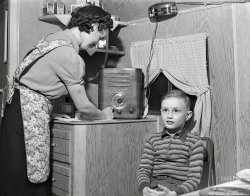
- Pontiac Depot: 1905
- ... RR, connecting Chicago to St. Louis and eventually, New Orleans.
29 years later the famous Route 66 will follow alongside this ... Posted by Dave - 08/10/2012 - 12:23am -
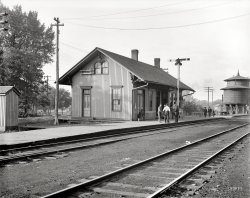
- Audubon Place: 1906
- New Orleans circa 1906. "Audubon Place." A private, gated street developed in ... inside of a refrigerator.
(The Gallery, DPC, New Orleans) ... Posted by Dave - 08/20/2022 - 11:27am -
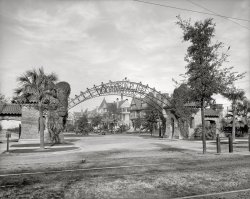
- Crushing It: 1941
- ... I citated cited "The Pause That Refreshed" from the New Orleans National WWII Museum link , but thnx for making clear that a ... Posted by Dave - 11/12/2020 - 11:00pm -
![Crushing It: 1941 August 1941. "Farm worker in beer parlor on a Sunday afternoon. Bruce Crossing, Michigan." Acetate negative by John Vachon for the Farm Security Administration. View full size.
Face the sun refreshed!Coca-Cola's "Face the Sun Refreshed" campaign slogan would soon become "The Pause That Refreshes Refreshed" by the time the United States entered World War II in December 1941.
[Coke's "Pause That Refreshes" slogan got its start in 1929, not 1941. "Face the Sun Refreshed" was not a campaign -- it's just this one advertisement. - Dave]
[I was aware Dave, that "The Pause That Refreshes" was introduced in 1929, it's therefore that I citated cited "The Pause That Refreshed" from the New Orleans National WWII Museum link, but thnx for making clear that a slogan does not make a campaign - Alex]
["The Pause That Refreshed" is the title of the Museum's web article. It is not a slogan that Coke ever used. And "Face the Sun Refreshed" is not a slogan -- it's ad copy for a single poster. The only slogan on the poster is "Delicious and Refreshing." - Dave]
YooperThat's what folks from the U.P. are called. It looks like he is dressed in his Sunday finest, including the "Big Yank" shirt. They invented the 'cigarette pocket shirt' but this does not look like one of those. Michigan must not have had Sunday "Blue Laws".
(on second look, maybe that is a 'cigarette pocket' shirt. Though maybe he prefers chewing his tobacco)
Open for BoozinessI made a business trip to Michigan about 15 years ago. I can attest to the fact the bars were all open on Sunday.
(The Gallery, Eateries & Bars, John Vachon, Small Towns)](https://www.shorpy.com/files/images/SHORPY-8c19945a.thumbnail.jpg)
- French Market: 1910
- Circa 1910. "French Market, New Orleans." Our second look at the market at N. Peters and Decatur streets. ... in 1909.
The French Market is eternal I lived in New Orleans in the late 1970s and early 80s and shopped at the French Market ... stones while pulling loaded cars.
(The Gallery, DPC, New Orleans, Stores & Markets) ... Posted by Dave - 08/14/2012 - 4:03pm -
![French Market: 1910 Circa 1910. "French Market, New Orleans." Our second look at the market at N. Peters and Decatur streets. Detroit Publishing Co. glass negative. View full size.
"The House Next Door"J.E. Dodson was an accomplished Broadway actor who appeared in several shows. "The House Next Door" was produced on Broadway by George M. Cohan & Sam Harris in 1909.
The French Market is eternalI lived in New Orleans in the late 1970s and early 80s and shopped at the French Market quite often. It's amazing how little it changed from this photo taken seventy years earlier, except for the clothing. I'm sure if I were to visit there again, it would be much the same.
Where the horsepower hits the streetJudging by the lack of wires over the tracks, and the generous, ah, deposits between the large cobbles, these tram tracks must have still been horse powered. Keep your skirts up ladies! And yes, we have green bananas!
[The streetcars here were electric, powered from the wires seen overhead. - Dave]
Mind the gapLook at those gutters.....deep as trenches! It's so pleasant to see Decatur free of bead and T-shirt shops. Central Grocery, half a block from where we're standing, was four years old when this photo was taken.
Mr. Dodson... playing in "The House Next Door," advertised on the utility pole, in a photograph taken the same year:
Cartoon fodder!There is a little drama going on here between that dog and the cat.
Glad the horses were sparedDave is correct, I missed the trolley wires amongst the other overhead wires. Glad that horses no longer had to walk on those uneven stones while pulling loaded cars.
(The Gallery, DPC, New Orleans, Stores & Markets)](https://www.shorpy.com/files/images/4a23693u.thumbnail.jpg)
- Labatut: 1938
- ... is the San Francisco Plantation between Baton Rouge and New Orleans which has a beautiful pair of cisterns rebuilt in the original ... Posted by Dave - 07/22/2012 - 4:42pm -
![Labatut: 1938 Pointe Coupee Parish, Louisiana, 1938. "Labatut. New Roads vicinity, built by Don Evariste de Barra, Spanish grandee, 1800. His descendants, the Labatut and Pugh families, still living here." Photo by Frances Benjamin Johnston. View full size.
It's still thereAnd you can see it here.
Spooky!When I was in seventh grade, I made a poster for a Halloween party. The house in it looked eerily like this.
TwilightLooks like a good place for vampires to hang out during the day!
SomewhereThe dog, the chicken, the orphan shoe. I know they're there somewhere, I just can't find them.
Jedi HouseWhen 138 years old look this good we will not!
LabatutI've looked all over the internet for a translation of Labatut ... as far as I can tell, it means "hidden away." Can someone let me know if I am right? I am so in love with FBJ's work, I can't wait to load Shorpy every day to see if there is something new from her archives!
[It's a family name. According to the caption, the Labatuts are descendants of Don Evariste. - Dave]
Obviously a loving restoration, except....couldn't Tom get some help whitewashing that picket fence after Aunt Polly told him to do it?
Beyond that, the house (in 1938) looked abandoned, what with a few of the windows being broken. Quite a beauty now, however.
Right on the leveeAfter picking through Google maps and street view, I noticed that the house is right across the road from the Mississippi River levee. I wonder how many floods this house has endured over the past 210 years.
Hail yes!Try and imagine the racket when a hailstorm collided with the galvanized roofing on the original home!
If the walls could talkThank you Minot for the additional info on Labatuts. Really interesting then and now. This house has seen alot of history! It must've been built well. Any ghost stories? Looks worthy of being registered as a historical site.
Running water, in the rainy seasonTo the right of the house is the foundation formerly holding a wooden cistern. These were common South Louisiana plantation houses of that era; they collected rainwater from the roof. (Rainwater was preferred to water from the muddy Mississippi which had to be let settle.) Most of the old cisterns are long gone; an exception is the San Francisco Plantation between Baton Rouge and New Orleans which has a beautiful pair of cisterns rebuilt in the original style.
I'm so happythat the house is still there and is being restored. Thanks Minot, for the info.
Family TiesI'm a Labatut. My grandfather grew up in this house. I haven't seen it in a long time. Good to see it restored.
(The Gallery, F.B. Johnston)](https://www.shorpy.com/files/images/01476u.thumbnail.jpg)
- Capital Traction: 1932
- ... mostly on the Embarcadero route as tourist attractions. New Orleans has fairly classic cars running on the St Charles line. The Orange ... Posted by Dave - 09/14/2011 - 4:42pm -
![Capital Traction: 1932 Washington, D.C., circa 1932. "Capital Traction Company trolley in car barn." 8x10 safety negative, National Photo Company Collection. View full size.
I Should Have KnownWhen I saw this Shorpy photo, I became instantly curious as to the origins of the offbeat name, "Capital Traction." A little research revealed that the company and its name were the brainchild of our US Congress. Now it all makes perfect sense to me.
[There were hundreds of traction companies in the early part of the century, the traction coming from a moving cable under the street. A lot of them eventually adopted electric propulsion or switched to buses. - Dave]
I wonderIf O. Roy Chalk had a framed copy of this picture somewhere in his offices when it was D.C. Transit? Neat picture, thanks, Dave for the posting.
CTC 679Back to the library:
Capital Traction 679 was part of a group built by Jewett in 1911, Nos. 621-700. Succeeding Capital Transit renumbered them 207-286.
These were part of the largest group of DC streetcars built by Jewett from 1910 to 1912. This series of cars was scrapped between 1945 and 1947.
Note this is NOT a "trolley car." There is no trolley on the roof. Many of this series never had a trolley pole; they ran off the conduit inside the slot between the running rails, indicating this car spent its career running in the DC inner-city.
The conduit system was mandated by Congress to eliminate unsightly wires along DC streets.
[Fascinating research! Generally speaking, a trolley car can be "any wheeled carriage running on a track." Over the years, Capital Traction operated both electric and cable-traction streetcars. Washington's only cable-car loop ran out of Capital traction's car barn in Georgetown. - Dave]
Transfer TableThe car is sitting on a transfer table. Transfer tables were used to switch cars using a much smaller space than a traditional yard with turnouts.
Going Sideways.I see the Capital Traction car shown on the transfer table collects it's its electric current from a shoe suspended between the rails in the centre of the track.
The rectangular checkered "manholes covers" allow maintenance of the current conductor under the pavement level.
This method eliminates all the above the surface of the street, trolley wires, support cables and poles, presenting a cleaner street view.
(Maybe Dave can find a photo of the current collection shoe hanging beneath a streetcar? I understand there were concrete pits in the streets where the shoes could be applied and removed at locations where streetcars so equipped could change from shoe operation to trolley pole and wire operation in suburbs.)
[See this post. - Dave]
The car shown has only two traction motors on the inner two axles.
The wheels on the outer two axles are of a smaller diameter than the inner wheels with the motors, and the journal boxes on the outer axles reflect this and are closer to the road surface.
Apparently some versions of this style of two-motor truck was more prone to derailment on curves than the standard streetcar truck with all the wheels the same diameter.
Some eight-wheel cars had only two motors for use in flat cities, many more cars had four motors, some cars had no motors at all and were trailers pulled by the motor car coupled ahead, with an electric jumper cable between the cars for the towed trailer's lights and so it's its Conductor could signal the Motorman in the front powered car.
The electric traction motor and it's its gearing to move the transfer table at right angles to the streetcar tracks on each side of it is visible to the right below the wooden walkway.
The controller for the table is to the left, and is similar to one found on a streetcar.
The power for the transfer table is picked up from power rails parallel to the table on the end similar to the "third rail" found in subways.
True Dave, butI'll grant that most would call this a trolley car. And CT did run some cable lines, but the cable was long gone by the c.1932 time of photo.
The slot in DC track was for spaced contacts which were swept by a skate or plow attached to the bottom of the car. The skate was always in touch with at least two contacts. [I believe New York City had the same conduit system.]
Any former residents of DC region about 60 years of age will remember the "plow pits" located near the District line; here the pit man would remove the skate or plow from under an outbound car while the car's crew would raise the trolley pole for the ride into the suburbs. Inbound cars reversed this procedure.
All of this is to make the point that CT 679 is an electric, not cable car.
Dave, I've got to believe Harris and Ewing had some photos of Washington's plow pits!
[There's no question about this being an electric streetcar. - Dave]
Pay-within Car
Washington Post, Jul 4, 1910.
District Railway Commission Hears Many Complaints, and Acts on Others.
A defense of the pay-as-you-enter cars was made in a communication received from Amherst W. Barber, of the general land office, who declared that the cars in question have done more to protect women passengers from rough crowds and smoke on the back platforms of the old-style cars than anything else.
Mr. Eddy reported to the commission that a new style pay-within car has been put in operation on the Fourteenth street line of the Capital Traction Company as an experiment. The car is similar to the pay-within cars which have been in operation on the Chevy Chase line for several months, but differs from these in that the entrance and exit doors are of the folding instead of the sliding type, and are operated manually instead of pneumatically. The door and folding step mechanism are so constructed that the doors can be opened and closed with little effort on the part of the motorman or conductor.
A wealth of detailThere was something rather splendid, and elegant, in the use of the clerestory type of roof in railway and street-car vehicles. It was common here in England up until the 1930s, but then, sadly, became history.
Modern tram-type and railway vehicles are undoubtedly extremely clever, but utterly soulless when compared to the beautiful designs of the vehicles from yesteryear.
As with all photographs on this site, there is a wealth of detail here. I was intrigued to see that the figure 7 in the "17" painted on the side of the pit (and almost directly beneath the 'CTO' symbol on the side of the vehicle) is in precisely the same font style as the figure 7's in the numbers 679 on the side of the vehicle. The Company obviously valued conformity to common standards!
I know that the old San Francisco cable cars are still operating, but are there any electric cars like 679 in the picture being operated, even if "just" in a museum?
Dave in England
Vintage StreetcarsSan Francisco has an active electric Muni system and operates a fleet of vintage cars mostly on the Embarcadero route as tourist attractions. New Orleans has fairly classic cars running on the St Charles line. The Orange Empire Trolley museum in So Cal runs cars on the weekend. Google will no doubt turn up much more detail regarding these and others.
Ad CopyI wonder what the ad partially visible in the penultimate window from the right says.
Boys Own stuffThere's more detail here for young lads than you'll get in a Meccano set. I notice Dr Who has just left, judging by the plasma warp through the image.
Capital Transit M Street ShopsThat photograph was taken in the Capital Traction M Street Shops, at 3222 M Street NW in Georgetown, DC. A photograph looking in the other direction is on page 289 of "100 Years of Capital Traction" by LeRoy O. King.
As Olde Buck notes, Car 679 is a Jewett, painted a solid dark apple green with silver pinstriping. With only two motors, they were noted for slow acceleration.
The car behind the door is one of the cars numbered from 26-85. Cars 26-45 were bought from J. G. Brill in 1918. Cars 46-85 were bought from Kuhlman in 1919. They were rebuilt in 1928 with leather seats, faster motors, and painted light grey with a green stripe on the upper half of the lower side panels. One car of this series (number 27) belongs to the National Capital Trolley Museum, who are presently restoring it to this appearance.
This information would put this photograph sometime between 1928 and 1933, when Capital Transit and Washington Railway and Electric merged to form Capital Transit. I'd figure the earlier end of that range, since that car in the background looks so fresh.
The M Street Shops remained in service until 1962 and the end of streetcar service in Washington DC. The site is now The Shoppes at Georgetown Park.
Odd sized wheels.This car uses the 39-E type wheelset. It was very wide popularity, and was a standard of New York, Brooklyn, Philadelphia, Chicago, and dozens of other cities throughout the U.S. With this version being one of the earliest examples of the "maximum Traction" truck. Unlike most trucks where the bolster is centered between the axles, to increase tractive effort, the bolster on this type of truck is offset toward the driving wheel side. (The larger wheel) Unfortunately, this also made the truck prone to derailing on the smaller "pony" wheel end. By 1930, the 39-E had fallen out of favor in the US. However a variant of this with the pony and driving wheels reversed, did continue use in the UK and Australia.
(The Gallery, D.C., DPC, Streetcars)](https://www.shorpy.com/files/images/31016u.thumbnail.jpg)
- Dixie Calendar: 1910
- Circa 1910. "New Orleans and Mississippi River from Hotel Grunewald." The business side of ... a major retail clothier and general department store in New Orleans for almost seventy years. City directories first list the company ... of taking a ferry boat across the river when we visited New Orleans. My father's folks lived in Belle Chase, just outside of Gretna. ... Posted by Dave - 08/08/2012 - 2:30pm -
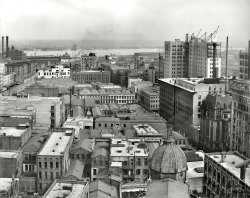
- The Archbishopric: 1910
- New Orleans circa 1910. "The Archbishopric." Note the cistern and chicken coop. ... until 1753.
The Picayune's Guide to New Orleans, 1900.
Archbishopric.
This is an exceedingly ... Ursulines presented it to the then reigning Archbishop of New Orleans as a place of residence for the archbishops of the diocese. It was ... Posted by Dave - 12/09/2012 - 1:32pm -
![The Archbishopric: 1910 New Orleans circa 1910. "The Archbishopric." Note the cistern and chicken coop. 8x10 inch dry plate glass negative, Detroit Publishing Company. View full size.
Still thereminus the Chicken Coop. A Google street view.
[Funny how the building looked much older a hundred years ago. - Dave]
Street View 0.00001The perspective in this photo reminds me a lot of some of Google's street views. Except this one is in grayscale.
[They even blurred out the pedestrian! - Dave]
Oldest Building in the Mississippi ValleyThe following entry from the 1900 Picayune's guide was wrong on the age of the building: the convent was designed by French Colonial Engineers in 1745 and was under construction until 1753.
The Picayune's Guide to New Orleans, 1900.
Archbishopric.
This is an exceedingly interesting place. It is the oldest building in Louisiana. Entrance may be had through a quaintly constructed portal, defended by double gates, piercing the wall in the middle of the Chartres street front. The porter's lodge is within this portal. The buildings face a spacious lawn. They were erected between 1727 and 1734 for the use of the Ursuline nuns, who came over from France, at Bienville's solicitations, to take charge of the military hospital, establish a charity hospital and a convent school for girls. The nuns resided in this ancient building until 1824. when they removed to their present domicile, a mile or two below the city.
The old building has seen various uses, not the least interesting of which is that in 1831 it was the State Capitol, and the legislature held its sessions within its walls. The building was at that time leased by the State of Louisiana from the Ursuline nuns. Shortly afterward, the lease having expired, the Ursulines presented it to the then reigning Archbishop of New Orleans as a place of residence for the archbishops of the diocese. It was so used until 1899, when a number of Catholic clergy and laity determined, shortly after the accession of Archbishop Chapelle, to purchase the Slocomb residence in Esplanade avenue as a place of residence for the archbishops.
The historic old site in Chartres street, however, is still retained as the “Archbishopric,” and is used for the transaction of all the official business of the archdiocese. The Archbishop and the Chancellor have their offices here, and it is the official place designated for all important ecclesiastical meetings. No one should leave New Orleans without visiting this ancient building. It remains exactly as .when first erected. The visitor should remark the ancient staircase, the steps of which are single, massive pieces of timber, deeply worn by the feet of many generations. The chapel contains a little oratory and shrine. The reception room, on the lower floor, is beautifully paneled in cypress, and contains a curious old clock. The shutters of cypress over the main entrance to the palace are over 160 years old, and are still perfectly sound. On the third floor of the building may still be seen the quaint little cells used by the Ursuline nuns in 1727, and the old-fashioned desk in the “community room,” at which the superioress sat and presided when the nuns met for instruction, meditation and prayer. …
ReplacedThat simple wood fence separating the formal garden from the service yard seems to have been replaced by a large hedge in the modern picture. A much better solution.
(The Gallery, DPC, New Orleans)](https://www.shorpy.com/files/images/SHORPY_4a23669a.thumbnail.jpg)
- King Dodo: 1910
- 1910. "French Opera House, New Orleans." Coming March 20: "King Dodo," a "phosphoronic comedy opera." 8x10 ... is in need of a paint job, or if the finish shown is some New Orleans distressed style of decorating?
While we're at it, is this ... go Opening in 1859 and fast becoming the social hub of New Orleans, the French Opera House on Bourbon at Toulouse Street was destroyed ... Posted by Dave - 06/11/2013 - 1:33pm -
![King Dodo: 1910 1910. "French Opera House, New Orleans." Coming March 20: "King Dodo," a "phosphoronic comedy opera." 8x10 glass negative. View full size.
LogicalIf you're gonna have an 'Opera House', you're gonna need an 'Opera Saloon'.
Fire escapes?I count two fire escape landings, both sharing the same vertical ladder. Not very reassuring in the event of a fire during a packed house.
Let's hope the back of the opera house featured multiple fire escapes with wide, steel staircases instead of ladders. Right.
In need of paint?Can someone explain whether the upper story is in need of a paint job, or if the finish shown is some New Orleans distressed style of decorating?
While we're at it, is this interesting building still standing?
How oddNot a sign of life.
[There's at least one ghost. -tterrace]
Hear the Eminent Doctor Fizz!A recording of "Gems from King Dodo," recorded in 1912. http://www.loc.gov/jukebox/recordings/detail/id/2761/
Only 9 years to goOpening in 1859 and fast becoming the social hub of New Orleans, the French Opera House on Bourbon at Toulouse Street was destroyed by fire on the night of December 4, 1919. The Four Points Sheraton Hotel now occupies the site.
King DodoA synopsis of the plot of King Dodo, along with some other information.
(The Gallery, New Orleans)](https://www.shorpy.com/files/images/SHORPY_4a19855a.thumbnail.jpg)
- Americus: 1937
- ... blog. It's one of my favorites. By the way, I'm live in New Orleans, so I especially enjoy the pictures of old New Orleans.
Is it 100% real Certain aspects of the clothes, appearance ... Posted by Dave - 07/25/2012 - 6:52pm -
![Americus: 1937 July 1937. "Thirteen-year old sharecropper boy near Americus, Georgia." Medium-format nitrate negative by Dorothea Lange. View full size.
Brings back memories.That boy looks like my brother Bill.
PlowboyHis clothes are falling off, but he looks so proud. Great picture.
A powerful photoSeventeen in 1941, I wonder if this boy would or could have enlisted. It looks like he's been working that plow for quite some years, and would be ready to move on, given any sort of chance; though he was possibly the family breadwinner.
There is nothing to sayJust look into that face.
My grandfather used a plow like this.He was so young, the handles would smack him in the head if he hit a rock. Think about that.
PovertyDave, this comment isn't really meant to be posted, but I want to thank you for not posting every comment that's submitted. As I'm sure you've found by now, just a simple photograph of a young black sharecropper will bring all sorts of racist comments. And who needs that?
[No such comments for this photo. - Dave]
Thanks for the great blog. It's one of my favorites. By the way, I'm live in New Orleans, so I especially enjoy the pictures of old New Orleans.
Is it 100% realCertain aspects of the clothes, appearance of the subject, the pose, all these items together just make me feel this is a fabricated picture. They did do those things even back then.
[Click here, take a look at the 5,000 or so photos in this series and judge for yourself. - Dave]
Hard workMy grandfather used to tell tales of walking all day behind one of these bottom plows, all day, one row at the time. There are still very many of these one-row plows stored away and forgotten sitting under barns all over Georgia to this day.
Today we have air conditioned cabs and 10+ row plows that can do in less than an hour what it would probably take this boy the better part of a week to do.
From what I can make out it looks like cotton he's plowing.
(The Gallery, Agriculture, Dorothea Lange)](https://www.shorpy.com/files/images/8b32269u.thumbnail.jpg)
- Filigree: 1937
- New Orleans, 1937. "Le Pretre Mansion, 716 Dauphine Street, built 1835-6. ... Schertz, "Legends of Louisiana," published by the New Orleans Journal. A photo of the mansion in this book is captioned "The ... cast iron was added later... probably in the
1850's when New Orleans was obsessed with the trend. The entablature
is missing above ... Posted by Dave - 07/19/2012 - 4:36pm -
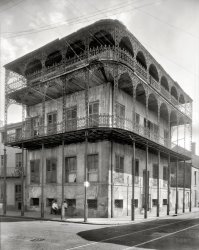
- Visiting the Torpedo Boats: 1906
- New Orleans circa 1906. "Visiting the torpedo boats." The Porter and the ... times. I note several black people, not surprising in New Orleans of that era, and that there are quite a few gay blades who have ... later in life.
(The Gallery, Boats & Bridges, DPC, New Orleans) ... Posted by Dave - 08/09/2012 - 6:47pm -
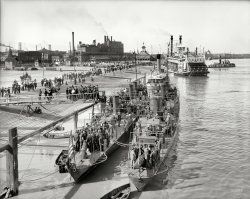
- Chinatown: 1900
- ... hand side of the street are reminiscent of the ones in New Orleans.
[A delight to the touch as well as the eyes. - tterrace] ... Posted by Dave - 07/18/2012 - 7:02pm -
![Chinatown: 1900 New York circa 1900. "Chinatown -- Mott Street." 8x10 inch dry plate glass negative, Detroit Publishing Company. View full size.
The view todayMany of the buildings are still there, and looks like as fun a place as ever to explore!
View Larger Map
Interesting architexture The railings on the buildings on the right hand side of the street are reminiscent of the ones in New Orleans.
[A delight to the touch as well as the eyes. - tterrace]
I should have used spell-check...:-)
Where Dr. C.S. Bok livedThis postcard is in my family’s collection. Dr. Chu Soule Bok lived on Mott St. near the place pictured on the postcard which was sent in 1911. Dr. Bok and my grandfather C.M. Austin became friends after meeting at Centenary Collegiate Institute in Hackettstown, NJ, in 1891. Several of C.S. Bok's letters are also in the family collection.
MSGHalf an hour after looking at this Shorpy photo, I felt the need to look at Shorpy again.
Am I seeing things?In the street, to the front and to the right of the horse-drawn wagon, there is something on the road itself -- a puddle, a piece of debris, something -- and the odd thing is it looks like it has letters on it? I see "ROBDEV"? It really does look like a puddle, but if the letters were a reflection, wouldn't they be backwards?
I also thought that maybe the photographer playfully left his name on the spot?
Dunno, would love to hear what y'all think.
[The thing you're seeing is a manhole cover with holes in it. -Dave]
Across the streetIs the WO HOP Chinese restaurant. A world famous institution since the 1930s, for all late night club-goers, at 17 Mott Street. This view is facing south.
Chinatown: 1900"And tell me what street
Compares with Mott Street
In July?
Sweet pushcarts gently gliding by.
The great big city's a wondrous toy
Just made for a girl and boy.
We'll turn Manhattan
Into an isle of joy."
-Richard Rodgers and Lorenz Hart
HeadlightThe candle lantern on the front of the horse cart should be adequate at 5 mph.
Step stylesIt is a fascinating picture, but one thing that struck me of all things is the variety of styles of steps, and that most are constructed out of wood, for a city block made of brick and stone, I thought this a little odd, not what I expected to see.
(The Gallery, DPC, NYC)](https://www.shorpy.com/files/images/SHORPY_4a08192a.thumbnail.jpg)
- Emporium of Transport: 1910
- ... our sojourn in the Crescent City. "Masonic Temple, New Orleans." Home to H.A. Testard's store ( "Bicycles, Automobiles" ). 8x10 ... on the site.
(The Gallery, Cars, Trucks, Buses, DPC, New Orleans, Stores & Markets) ... Posted by Dave - 07/19/2012 - 4:38pm -
